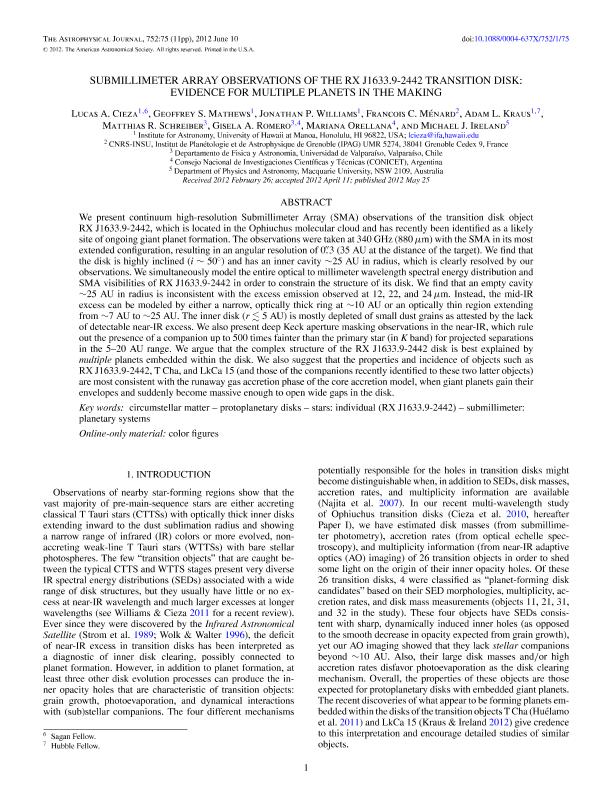Mostrar el registro sencillo del ítem
dc.contributor.author
Cieza, Lucas A.

dc.contributor.author
Mathews, Geoffrey S.

dc.contributor.author
Williams, Jonathan P.

dc.contributor.author
Menard, Francois C.

dc.contributor.author
Kraus, Adam L.

dc.contributor.author
Schreiber, Matthias R.

dc.contributor.author
Romero, Gisela Andrea

dc.contributor.author
Orellana, Mariana Dominga

dc.contributor.author
Ireland, Michael J.

dc.date.available
2017-05-18T14:27:53Z
dc.date.issued
2012-06
dc.identifier.citation
Cieza, Lucas A.; Mathews, Geoffrey S.; Williams, Jonathan P.; Menard, Francois C.; Kraus, Adam L.; et al.; Submillimeter array observations of the RX J1633.9-2442 transition disk: evidence for multiple planets in the making; Iop Publishing; Astrophysical Journal; 752; 1; 6-2012; 75-86
dc.identifier.issn
0004-637X
dc.identifier.uri
http://hdl.handle.net/11336/16628
dc.description.abstract
We present continuum high-resolution Submillimeter Array (SMA) observations of the transition disk object RX J1633.9-2442, which is located in the Ophiuchus molecular cloud and has recently been identified as a likely site of ongoing giant planet formation. The observations were taken at 340 GHz (880 μm) with the SMA in its most extended configuration, resulting in an angular resolution of 0.3arcsec (35 AU at the distance of the target). We find that the disk is highly inclined (i ~ 50°) and has an inner cavity ~25 AU in radius, which is clearly resolved by our observations. We simultaneously model the entire optical to millimeter wavelength spectral energy distribution and SMA visibilities of RX J1633.9-2442 in order to constrain the structure of its disk. We find that an empty cavity ~25 AU in radius is inconsistent with the excess emission observed at 12, 22, and 24 μm. Instead, the mid-IR excess can be modeled by either a narrow, optically thick ring at ~10 AU or an optically thin region extending from ~7 AU to ~25 AU. The inner disk is mostly depleted of small dust grains as attested by the lack of detectable near-IR excess. We also present deep Keck aperture masking observations in the near-IR, which rule out the presence of a companion up to 500 times fainter than the primary star (in K band) for projected separations in the 5-20 AU range. We argue that the complex structure of the RX J1633.9-2442 disk is best explained by multiple planets embedded within the disk. We also suggest that the properties and incidence of objects such as RX J1633.9-2442, T Cha, and LkCa 15 (and those of the companions recently identified to these two latter objects) are most consistent with the runaway gas accretion phase of the core accretion model, when giant planets gain their envelopes and suddenly become massive enough to open wide gaps in the disk.
dc.format
application/pdf
dc.language.iso
eng
dc.publisher
Iop Publishing

dc.rights
info:eu-repo/semantics/openAccess
dc.rights.uri
https://creativecommons.org/licenses/by-nc-sa/2.5/ar/
dc.subject
Circumstellar Matter
dc.subject
Protoplanetary Disk
dc.subject
Rx J1633.9-2442 (Galaxia)
dc.subject
Submillimeter Astronomy
dc.subject.classification
Otras Ciencias Naturales y Exactas

dc.subject.classification
Otras Ciencias Naturales y Exactas

dc.subject.classification
CIENCIAS NATURALES Y EXACTAS

dc.title
Submillimeter array observations of the RX J1633.9-2442 transition disk: evidence for multiple planets in the making
dc.type
info:eu-repo/semantics/article
dc.type
info:ar-repo/semantics/artículo
dc.type
info:eu-repo/semantics/publishedVersion
dc.date.updated
2017-05-15T17:58:05Z
dc.journal.volume
752
dc.journal.number
1
dc.journal.pagination
75-86
dc.journal.pais
Estados Unidos

dc.journal.ciudad
Londres
dc.description.fil
Fil: Cieza, Lucas A.. University Of Hawaii At Manoa; Estados Unidos
dc.description.fil
Fil: Mathews, Geoffrey S.. University Of Hawaii At Manoa; Estados Unidos
dc.description.fil
Fil: Williams, Jonathan P.. University Of Hawaii At Manoa; Estados Unidos
dc.description.fil
Fil: Menard, Francois C.. Institut de Planetologie et de Astrophysique de Grenoble; Francia
dc.description.fil
Fil: Kraus, Adam L.. University Of Hawaii At Manoa; Estados Unidos
dc.description.fil
Fil: Schreiber, Matthias R.. Universidad de Valparaíso; Chile
dc.description.fil
Fil: Romero, Gisela Andrea. Universidad de Valparaíso; Chile. Consejo Nacional de Investigaciones Científicas y Técnicas; Argentina
dc.description.fil
Fil: Orellana, Mariana Dominga. Consejo Nacional de Investigaciones Científicas y Técnicas; Argentina
dc.description.fil
Fil: Ireland, Michael J.. Macquarie University; Australia
dc.journal.title
Astrophysical Journal

dc.relation.alternativeid
info:eu-repo/semantics/altIdentifier/url/http://iopscience.iop.org/0004-637X/752/1/75/
dc.relation.alternativeid
info:eu-repo/semantics/altIdentifier/doi/http://dx.doi.org/10.1088/0004-637X/752/1/75
Archivos asociados
